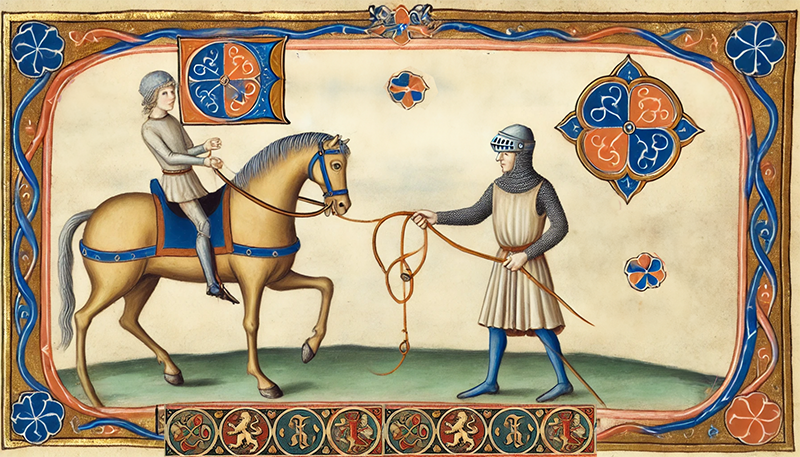The Book of the Order of Chivalry (c. 1275), was written by Ramon Llull (1232–1315), a polymath and Christian mystic from Majorca. Llull thought that knights should be chosen, trained, and ordained like priests. Llull’s book became a handbook of chivalry throughout much of Europe. Being a Christian mystic, of course he writes about Chivalry using Christian vocabulary. But I think his ideas transcend any particular Spiritual Tradition.
Llull wrote over 250 books on a wide range of subjects, including theology, philosophy, logic, science, and even poetry. (And one on Chivalry!) He is best known for his book Ars Magna — a groundbreaking philosophical and logical system that aimed to uncover universal truths using mathematics — now considered the invention of Mathematical Combinatorics. He was also known for his interest in memory and logical systems more generally: his method of linking virtues to physical objects is an example of the ancient memory technique known as the Memory Palace.
An overview of the Order of Chivalry, and a linked table of contents to all my blogs (with music) on various chapters of Llull’s book can be found HERE.

Here Llull equates the horse’s bridle with ‘courtesy’:
The bridle is given to the horse and the reins of the bridle are placed in the knight’s hands, so that the knight may hold his horse to his will and refrain him. And this signifies that a knight ought to refrain his tongue and speak no foul words nor false; and also it signifies that he ought to refrain his hands, that he give not so much that he be suffering and needy, that he beg nor demand nothing, nor be too hardy, but that his hardiness have reason and temperance.
Llull uses the image of the horse’s bridle to illustrate the importance of courtesy and self-control in the life of a knight. Just as the bridle allows the knight to guide and control his horse, courtesy serves as a means for the knight to govern his speech and actions. This metaphor highlights the idea that true courtesy is not simply about polite behavior, but about the conscious restraint and balance that reflect a knight’s inner discipline and moral responsibility.
“The bridle is given to the horse and the reins of the bridle are placed in the knight’s hands.”
The bridle, a tool used to guide and control the horse, becomes a symbol of the knight’s ability to direct his own actions. The reins in the knight’s hands signify the knight’s responsibility to exercise control over his impulses, ensuring that his actions and words are guided by wisdom and respect for others. In many spiritual traditions, self-control is viewed as a key virtue. In Buddhism, for instance, the practice of right speech involves the mindful use of words to avoid harm, while in the Stoic tradition, self-control is seen as the foundation for living a virtuous life, ensuring that one’s actions are guided by reason rather than impulse.
“A knight ought to refrain his tongue and speak no foul words nor false.”
Llull emphasizes that courtesy begins with the control of speech. The knight is expected to refrain from foul or false words, recognizing the power that speech has to uplift or harm. This self-restraint in speech reflects the deeper principle of courtesy, which is not merely about avoiding offense but about fostering respect and harmony through thoughtful communication. The importance of controlling one’s speech is echoed in many traditions. In Hinduism, the concept of ahimsa (non-violence) extends to speech, where harmful or false words are seen as a form of violence. In Confucianism, courtesy in speech is linked to the virtue of ren (benevolence), emphasizing the role of communication in maintaining social harmony.
“He ought to refrain his hands, that he give not so much that he be suffering and needy.”
Llull extends the metaphor of the bridle to include the knight’s actions, particularly his generosity. While generosity is a virtue, Llull cautions that it must be balanced with self-care and prudence. The knight must refrain from giving so much that he impoverishes himself, as this would undermine his ability to fulfill his duties. Courtesy, in this sense, is about moderation and balance—knowing when and how much to give, so that one can continue to serve others without becoming a burden. In Aristotle’s Nicomachean Ethics, the concept of phronesis (practical wisdom) emphasizes the need for balance in virtuous actions, ensuring that generosity, courage, and other virtues are practiced with moderation and reason.
“Nor be too hardy, but that his hardiness have reason and temperance.”
Llull concludes by reminding the knight that his bravery and strength, symbolized by the horse’s hardiness, must also be tempered with reason and courtesy. True strength is not reckless or impulsive; it is guided by wisdom and consideration for others. The knight’s courage must be balanced with temperance, ensuring that his actions serve a greater good rather than merely demonstrating personal valor. This balance between courage and temperance is a recurring theme in chivalric and spiritual traditions. In Taoism, the principle of wu wei (effortless action) suggests that true power comes from acting in harmony with the natural order, without force or excess. In the Christian tradition, the virtue of temperance ensures that strength and bravery are guided by humility and love.
In conclusion, Llull’s metaphor of the horse’s bridle as courtesy highlights the knight’s responsibility to exercise self-control in both speech and action. Courtesy is not just about polite behavior but about the disciplined restraint that allows the knight to serve others with wisdom, balance, and respect. Across spiritual traditions, the ability to govern one’s impulses and act with moderation is seen as a mark of true strength and virtue. Llull’s vision reminds us that courtesy, like the bridle, allows us to navigate life’s challenges with grace and integrity, ensuring that our actions reflect both inner discipline and outward respect for the world around us.



Leave a Reply